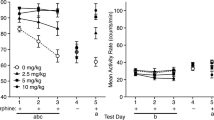Abstract
The present study examined the effects of naloxone on acquisition and expression of morphine-induced conditioned place preference (CPP). Three groups of rats were given morphine (5 mg/kg, SC), both morphine and naloxone (1 mg/kg, SC), or saline paired with a distinctive environment. On alternating days they were given saline paired with another distinctive environment. After four exposures to each environment, the animals were given a preference test in which they had access to both environments simultaneously while under the influence of either naloxone (1 mg/kg, SC) or saline. Morphine-conditioned animals showed CPP evident as an increased amount of time spent in the drug-associated environment relative to saline controls. Rats given both naloxone and morphine during conditioning, and saline on the test day, did not show CPP. In contrast, morphine-conditioned animals given naloxone on the test day showed stronger CPP than morphine-conditioned animals given saline. These findings indicate that naloxone blocks the acquisition, but enhances the expression of morphine-induced CPP. In a separate experiment, the effects of naloxone on locomotor activity were determined during the CPP test. The results indicated that naloxone decreased locomotor activity. In morphine-conditioned animals only, naloxone also produced an increase in the amount of time per entry in the drug-associated environment. The results suggest that naloxone may enhance morphine-induced CPP by decreasing locomotor activity that may otherwise compete with expression of CPP.
Similar content being viewed by others
References
Bardo MT, Miller JS, Neisewander JL (1984) Conditioned place preference with morphine: The effect of extinction training on the reinforcing CR. Pharmacol Biochem Behav 21:545–549
Beach HD (1957) Morphine addiction in rats. Can J Psychol 11:104–112
Blander H, Hunt T, Blair R, Amit Z (1984) Conditioned place preference: An evaluation of morphine's positive reinforcing properties. Psychopharmacology 84:124–127
Bozarth MA (1987) Conditioned place preference: a parametric analysis using systemic heroin injections. In: Bozarth MA (ed) Methods of assessing the reinforcing properties of abused drugs. Springer, Berlin Heidelberg New York, pp 241–273
Drawbaugh R, Lal H (1974) Reversal by narcotic antagonist of a narcotic action elicited by a conditional stimulus. Nature 247:65–67
Ettenberg A, Pettit HO, Bloom FE, Koob GF (1982) Heroin and cocaine self-administration in rats: mediation by separate neural systems. Psychopharmacology 78:204–209
Grabowski J, Cherek DR (1983) Conditioning factors in opiate dependence. In: Smith JE, Lane JD (eds) The neurobiology of opiate reward processes. Elsevier, Amsterdam, pp 175–210
Katz RJ, Gormezano G (1979) A rapid and inexpensive technique for assessing the reinforcing effects of opiate drugs. Pharmacol Biochem Behav 11:231–233
Koob GF, Pettit HO, Ettenberg A, Bloom FE (1984) Effects of opiate antagonists and their quartenary derivatives on heroin self-administration in the rat. J Pharmacol Exp Ther 229:481–486
Kumar R (1972) Morphine dependence in rats: secondary reinforcement from environmental stimuli. Psychopharmacologia 25:332–338
Lal H, Miksic S, Drawbaugh R, Numan R, Smith N (1976a) Alleviation of narcotic withdrawal syndrome by conditioned stimuli. Pavlov J Biol Sci 11:251–262
Lal H, Miksic S, Smith N (1976b) Naloxone antagonism of conditioned hyperthermia: an evidence for release of endogenous opioid. Life Sci 18:971–975
Mucha RF, Iversen SD (1984) Reinforcing properties of morphine and naloxone revealed by conditioned place preferences: a procedural examination. Psychopharmacology 82:241–247
Neisewander JL, Bardo MT (1987) Expression of morphine-conditioned hyperactivity is attenuated by naloxone and pimozide. Psychopharmacology 93:314–319
O'Brien CP, Ternes JW, Grabowski J, Ehrman R (1981) Classically conditioned phenomena in human opiate addiction. In: Thompson T, Johanson C (eds) Behavioral pharmacology of human drug dependence. National Institute on Drug Abuse, DHHS, Washington DC, Publication No. (ADM) 81-1137, pp 107–115
Rossi NA, Reid LD (1976) Affective states associated with morphine injections. Physiol Psychol 4:269–274
Stewart J, de Wit H, Eikelboom R (1984) Role of unconditioned and conditioned drug effects in the self-administration of opiates and stimulants. Psychol Rev 91:251–268
van der Kooy D (1987) Place conditioning: a simple and effective method for assessing the motivational properties of drugs. In: Bozarth MA (ed) Methods of assessing the reinforcing properties of abused drugs. Springer, Berlin Heidelberg New York, pp 229–240
Vezina P, Stewart J (1987a) Conditioned locomotion and place preference elicited by tactile cues paired exclusively with morphine in an open field. Psychopharmacology 91:375–380
Vezina P, Stewart J (1987b) Morphine conditioned place preference and locomotion: the effect of confinement during training. Psychopharmacology 93:257–260
Wei E, Loh HH, Way EL (1973) Quantitative aspects of precipitated abstinence in morphine-dependent rats. J Pharmacol Exp Ther 184:398–403
Wikler A, Pescor FT (1967) Classical conditioning of a morphine abstinence phenomenon, reinforcement of opioid drinking behavior and ‘relapse’ in morphine addicted rats. Psychopharmacologia 10:255–284
Author information
Authors and Affiliations
Rights and permissions
About this article
Cite this article
Neisewander, J.L., Pierce, R.C. & Bardo, M.T. Naloxone enhances the expression of morphine-induced conditioned place preference. Psychopharmacology 100, 201–205 (1990). https://doi.org/10.1007/BF02244406
Received:
Revised:
Issue Date:
DOI: https://doi.org/10.1007/BF02244406




